
The sieges of Taunton were a series of three blockades during the First English Civil War. The town of Taunton, in Somerset, was considered to be of strategic importance because it controlled the main road from Bristol to Devon and Cornwall. Robert Blake commanded the town's Parliamentarian defences during all three sieges, from September 1644 to July 1645.

The fortifications of Portsmouth are extensive due to its strategic position on the English Channel and role as home to the Royal Navy. For this reason, Portsmouth was, by the 19th century, one of the most fortified cities in the world. The fortifications have evolved over the centuries in response to changes in tactics and technology and the area defended has increased. While the first defences focused on Portsmouth harbour, in step with the fortifications of Gosport, later defensive structures protected the whole of Portsea Island and an increasing distance inland. At the same time, the fortifications of Portsmouth and Gosport became part of the wider fortifications of the Solent. Old Portsmouth, on the southwest corner of Portsea Island, has been walled for much of its history.

The Hilsea Lines are a line of 18th- and 19th-century fortifications built at Hilsea to protect the northern approach to Portsea Island, an island off the southern coast of England which forms the majority of the city of Portsmouth and its key naval base. They are now used as a greenspace and leisure area, also known locally as Foxes Forest.

The Device Forts, also known as Henrician castles and blockhouses, were a series of artillery fortifications built to defend the coast of England and Wales by Henry VIII. Traditionally, the Crown had left coastal defences in the hands of local lords and communities but the threat of French and Spanish invasion led the King to issue an order, called a "device", for a major programme of work between 1539 and 1547. The fortifications ranged from large stone castles positioned to protect the Downs anchorage in Kent, to small blockhouses overlooking the entrance to Milford Haven in Pembrokeshire, and earthwork bulwarks along the Essex coast. Some forts operated independently, others were designed to be mutually reinforcing. The Device programme was hugely expensive, costing a total of £376,000 ; much of this was raised from the proceeds of the Dissolution of the Monasteries a few years before.
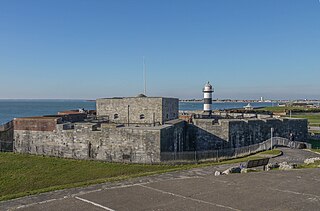
Southsea Castle, historically also known as Chaderton Castle, South Castle and Portsea Castle, is an artillery fort originally constructed by Henry VIII on Portsea Island, Hampshire, in 1544. It formed part of the King's Device programme to protect against invasion from France and the Holy Roman Empire, and defended the Solent and the eastern approach to Portsmouth. The castle had a square central keep, two rectangular gun platforms to the east and west, and two angled bastions to the front and rear, and was an early English example of the trace italienne-style of fortification popular on the Continent. The Cowdray engraving of the Battle of the Solent in 1545 depicted Henry VIII visiting the castle. Despite several serious fires, it remained in service and saw brief action at the start of the English Civil War in 1642 when it was stormed by Parliamentary forces.

The Second Battle of Newbury was a battle of the First English Civil War fought on 27 October 1644, in Speen, adjoining Newbury in Berkshire. The battle was fought close to the site of the First Battle of Newbury, which took place in late September the previous year.

The Battle of Langport took place on 10 July 1645 during the First English Civil War, near Langport in Somerset. Following its success at Naseby in June, the New Model Army under Sir Thomas Fairfax destroyed the last Royalist field army, led by Lord Goring. Parliamentarian victory allowed them to besiege the Royalist port of Bristol, which surrendered in September.
The siege of Gloucester took place between 10 August and 5 September 1643 during the First English Civil War. It was part of a Royalist campaign led by King Charles I to take control of the Severn Valley from the Parliamentarians. Following the costly storming of Bristol on 26 July, Charles invested Gloucester in the hope that a show of force would prompt it to surrender quickly and without bloodshed. When the city, under the governorship of Lieutenant-Colonel Edward Massey, refused, the Royalists attempted to bombard it into submission. Massey adopted an aggressive defence, and the Royalist positions outside the city were regularly disrupted by Parliamentarian raids. The Royalist artillery proved inadequate for the task of siege work and, faced with a shortage of ammunition, the besiegers attempted to breach the city walls by mining. With Royalist miners about to reach the city's east gate and the defenders critically low on gunpowder, a Parliamentarian army led by the Earl of Essex arrived and forced Charles to lift the siege.

Portsbridge Creek, known officially as Portsea Creek, formerly as Portsea Lake and informally as Ports Creek, Port Creek, Portcreek and Canal Creek is a tidal waterway just off the southern coast of England that runs between Portsea Island and the mainland from Langstone Harbour to Tipner Lake.
Richard Norton of Southwick Park, was an English landowner and politician who sat in the House of Commons at various times between 1645 and 1691. He was a colonel in the parliamentary army in the English Civil War and for a time he commanded the Parliamentary forces besieging Basing House. He was Governor of Portsmouth for Parliament during the Civil War and for Charles II after the Restoration.

The siege of Basing House near Basingstoke in Hampshire, was a Parliamentarian victory late in the First English Civil War. Whereas the title of the event may suggest a single siege, there were in fact three major engagements. John Paulet, 5th Marquess of Winchester owned the House and as a committed Royalist garrisoned it in support of King Charles I, as it commanded the road from London to the west through Salisbury.
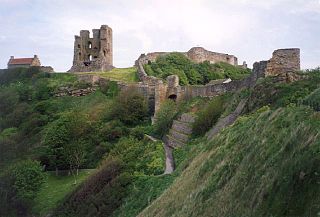
The Great Siege of Scarborough Castle was a major conflict for control of one of England's most important stone fortresses during the First English Civil War fought between the Parliamentarians and the Royalists loyal to King Charles I. In February 1645, Parliamentarians laid siege to Scarborough Castle. For five months, they bombarded it, destroying most of the keep, and engaged in bloody fighting before the defenders finally surrendered.
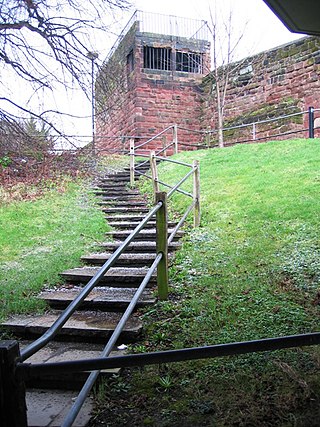
The siege of Chester occurred over a 16-month period between September 1644 and February 1646 during the First English Civil War. In the engagement, Sir William Brereton and the Parliamentarians were ultimately successful in taking possession of the city and Royalist garrison commanded by Lord Byron.

The siege of Chichester was a victory by Parliamentarian forces led by Colonel William Waller over a small Royalist garrison. The siege was one of the key events in the First English Civil War by Waller to secure southern England and declare it for Parliament. The siege lasted five days and ended with surrender by the Royalists. Despite the Royalist surrender, Waller's troops proceeded to sack and desecrate Chichester Cathedral.

The capture of Wakefield occurred during the First English Civil War when a Parliamentarian force attacked the Royalist garrison of Wakefield, Yorkshire. The Parliamentarians were outnumbered, having around 1,500 men under the command of Sir Thomas Fairfax, compared to the 3,000 led by George Goring in Wakefield. Despite being outnumbered, Parliamentarians successfully stormed the town, taking roughly 1,400 prisoners.

The Storming of Farnham Castle occurred on 1 December 1642, during the early stages of the First English Civil War, when a Parliamentarian force attacked the Royalist garrison at Farnham Castle in Surrey. Sir John Denham had taken possession of the castle for the Royalists in mid-November, but after the Royalists had been turned back from London at the Battle of Turnham Green, a Parliamentarian force under the command of Sir William Waller approached the castle. After Denham refused to surrender, Waller's forces successfully stormed the castle. They captured it in under three hours, mostly due to the unwillingness of the Royalist troops to fight. This allowed the Parliamentarians to get close enough to breach the gates, after which the garrison surrendered.
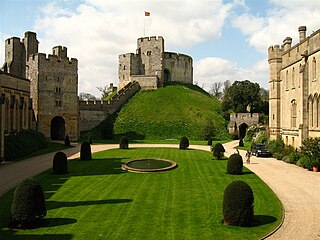
The siege of Arundel took place during the First English Civil War, from 19 December 1643 to 6 January 1644, when a Royalist garrison surrendered to a Parliamentarian army under Sir William Waller.
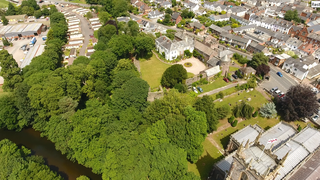
The Siege of Tiverton took place in October 1645 during the First English Civil War, when a Royalist garrison surrendered to a detachment of the New Model Army.

The Siege of Bridgwater took place in July 1645, during the First English Civil War, when a Royalist garrison surrendered to a Parliamentarian force under Sir Thomas Fairfax.
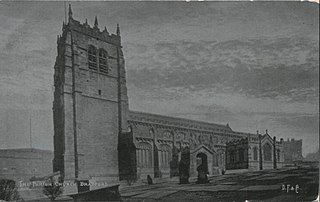
The sieges of Bradford, were two very short-lived sieges that took place separately in the town of Bradford, Yorkshire, in December 1642 and early July 1643, just after the Royalist victories in Pontefract (1642), and the Battle of Adwalton Moor (1643) respectively. In the second siege, with the Parliamentarian forces dispersed to the west in and around Halifax, the Earl of Newcastle subjected Bradford to a brief siege to enforce rule and allegiance to the king.

















